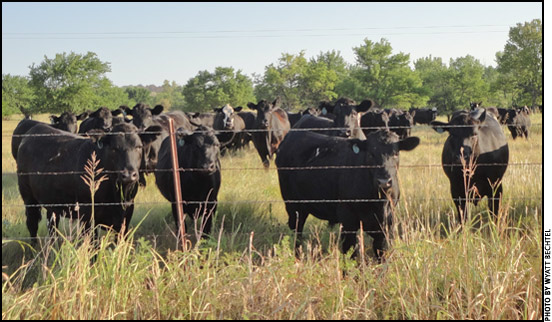
In the Cattle Markets
Summer grazing potential
A spring much warmer than normal in the Northern Plains and in other areas as well has grass greening up earlier than normal. Given the volatile prices that have been occurring, what is the profit potential for grazing calves this summer?
Calf and feeder-cattle prices are at record-high levels, but have been volatile and in a general downtrend for the last several weeks. The CME Feeder Cattle Price Index, which is a good barometer for 650-850-pound (lb.) feeder-steer prices in the United States, has declined about $8 per hundredweight (cwt.) since peaking at $157.45 on Feb. 14. Likewise, September CME feeder-cattle futures were trading at $163-$164 per cwt. in early March, and declined to $151-$152 in early April. During the second week of April, September futures rallied to the $156-$157 range.
Local calf prices will likely vary depending on pasture and range conditions, which vary considerably across the United States. Parts of the Northern Plains are drier than last year at this time, while moisture conditions have improved considerably in some regions of the Southern Plains. The most recent drought monitor (http://droughtmonitor.unl.edu) showed extreme to exceptional drought in Western Texas/Eastern New Mexico and the Southeastern United States. Moderate to severe drought is prevalent in the Southwest. Abnormally dry conditions in the Northern Plains were likely helped by widespread rains over the weekend.
Lower feeder-cattle supplies should be supportive to prices. The 2011 calf crop was down 1% and estimated feeder-cattle supplies outside of feedlots on Jan. 1, 2012, were estimated to be down about 4%. However, feeder-cattle prices during the summer will be influenced by fed-cattle prices and corn prices, which have been volatile, and will likely continue to be volatile.
Since prices and moisture conditions are changing daily, carefully computing expected costs and returns is necessary to assess the prospects for grazing calves. As an example, I looked at auction market prices in North Dakota for the second week of April. Prices for 550-600-lb. feeder steers ranged from $166 to $184.50 with an average of about $180. Prices for 750-800-lb. steers ranged from $139 to $154 with a $151 average. So, the $15 to $20 per cwt. ranges in prices for the individual market classes could also affect profitability substantially.
I have a Northern Plains example summer grazing budget spreadsheet on my website at www.ag.ndsu.edu/livestockeconomics/Budgets. There is both an example and a column for your expected costs and returns. A PowerPoint presentation with charts showing current supply and demand factors affecting the market is available. For discussion purposes, I used the average North Dakota 550-lb. steer price of $1.80 and the $151 price for 790-lb. steers. Given the example $100 pasture costs and additional $68 costs, the total cost of gain was $70 per cwt. with about $35 per head projected profit.
What is the chance of receiving $151 for 790-lb. steers in the fall? September feeder cattle futures are trading at $156-$157 and the September basis for average North Dakota auction market prices is about par. So, with prudent price risk management, summer grazing can be profitable.
For those of you in the Southern Plains, a co-author of this column, Dillon Feuz at Utah State University, has a stocker calculator at http://cattlemarketanalysis.org/stocker.html.







